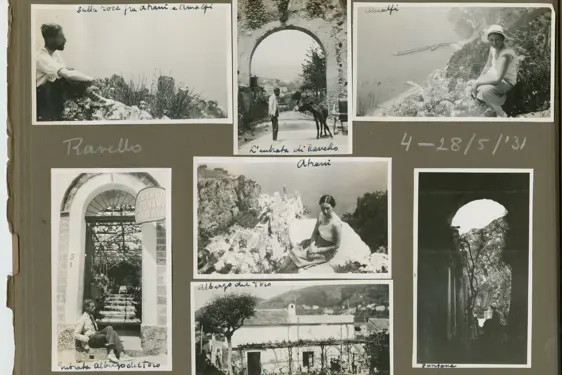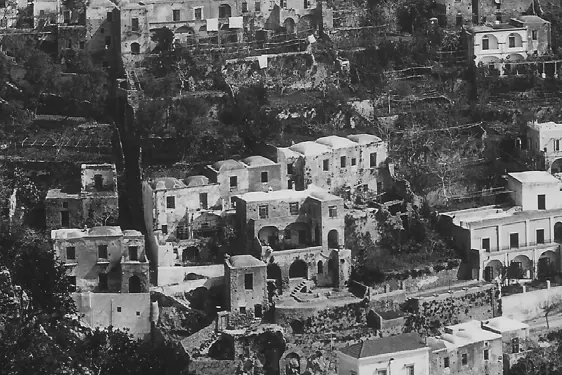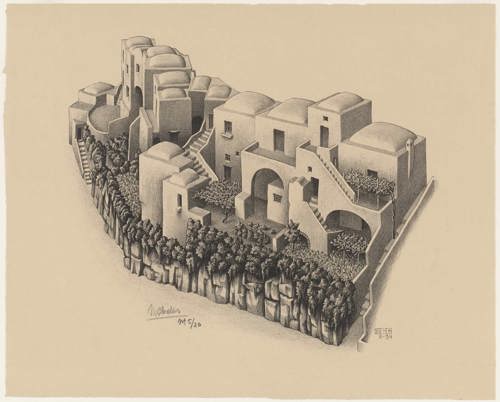ESCHER IN POSITANO
26.06.2025 ART & CULTURE
For eleven years, from 1925 to 1936, Escher would embark on exploratory trips to wild parts of Italy that had not yet, in appearance at least, been touched by the 20th century – regions like Abruzzo, Sicily, Calabria, and northern Lazio. But he would always return, sooner or later, to the Amalfi Coast, which held a special place in his heart.
It was here, in Ravello, on 31 March 1923, that he met Jetta Umiker, the woman who would soon become his wife. They married just over a year later and moved to Rome, where their first two sons were born. But Jetta and Maurits would often head back to the places south of Naples where their love had blossomed. However, it was not just romance that drew the artist here. He was fascinated by the organic townscapes of this vertical world, the way landscape and human habitation seemed to merge and cooperate.

View
Atrani, a small fishing village east of Amalfi, was a particular magnet for Escher. He and Jetta visited several times. According to Micky Piller, former curator at the Escher in Het Paleis museum in The Hague, “Escher’s visit to Atrani in May 1931 appears to have made a deep and lasting impression on him and on his work. In his inimitable style, he turned the Collegiata di Santa Maria Maddalena into one of the most iconic buildings of his entire oeuvre”.
This ancient church resembles the bridge of an urban ship fending the Mediterranean waves. Escher first depicted it in a 1931 lithograph in which the circular belltower of the Collegiata rises like a mast. The artist seems to be searching, in this seminal work, for the secret of how a rocky spur evolved into an organic, communal human settlement. Later, after the rise of Mussolini’s Fascist regime forced the strongly anti-auhoritarian Escher and his wife to move away from Italy, a remembered, transformed Atrani would become the centrepiece of his celebrated Metamorphosis series, in which the church and houses of the Amalfi Coast village refract into tessellated patterns.
Two other earlier Atrani works, Dilpidated Houses and Covered Alley in Atrani, both created in 1931, channel the spirit of 18th-century antiquarian artist Giovanni Battista Piranesi’s Carceri d’invenzione or ‘Imagined Prisons’, riffing on ancient built structures and drawing out, literally, their fantastical side, their dystopian drama.

Positano features only once in Escher’s oeuvre, in the 1934 lithograph (Old) Houses in Positano. But it’s an important work that goes to the heart of the Dutch artist’s obsession with the Costiera amafitana. The study arose from a visit Maurits and Jetta made in May and June 1934, ten years into their marriage. It depicts a group of houses detached from the urban palimpsest they inhabit, as if afloat in the sea.
The connected cluster of houses display the typical ‘bread roll’ roofs and external staircases of the traditional Amalfi Coast dwelling. Escher wrote in a letter to a friend that “When it comes to architecture, in my prints I have been strongly influenced by southern Italian buildings, where Norman, Romanesque, Saracen and Moorish influences can often be distinguished. I am fond of “bread roll” domes and flat, whitewashed roofs and plastered walls (see Dream, Cycle, Print Gallery, Belvedere, Ascending and Descending, Waterfall). Almost all these elements I saw on the Amalfi coast (Positano, Amalfi, Atrani, Maiori, Minori, Ravello).”
A photo of Jetta perched on a rock at Marina Grande exists from that early summer sojourn. But Escher never left any record of the exact location of the houses he drew in this celebrated lithograph.
In the search for an answer, Le Sirenuse Journal turned to Daniele Esposito, a positanese born and bred who is passionate about the cultural history of his hometown and the preservation of its heritage. Over the years he has assembled an important collection of old photographs of Positano that form an important resource for the study of its architectural and social evolution.
Esposito is familiar with the Escher drawing, and like us, he believes that it is, at least in part, “an architectural fantasy”. He points out that “certain details would be impossible to find in a single group of buildings” and believes that the Dutch artist either worked from a series of sketches of different houses or had access to photos of them, making, in the final work, “a kind of collage”.
However, Esposito feels that while the final work is a composite, it is still possible to identify some of the local houses that inspired Escher’s print. The more he compared the work with some of the vintage black and white photos in his collection, the more he became convinced that the artist had his sights set on one or two groups of houses in the Fornillo district of Positano, which rises up the hill from the beach of the same name towards the Chiesa Nuova church.

View
One cluster of houses in particular contains, for Esposito, many of the design details present in the artist’s Positano lithograph. “If you look at this photograph from the 1930s”, he explains, “you see several elements in common with the drawing, even though they’ve been moved around, and are viewed from a different perspective”. Esposito points out the staircases, the abundance of greenery within the property’s walls, and the rocky escarpment below “which has been cut”, he says, “in such a way that it could easily accommodate a road”. He adds that to see this architectural complex today from the same angle, “you’d need a drone”. But Escher, who loved to play with perspective and mirror views, seemed always to possess his own inner drone. He delighted in seeing the world from a multiplicity of different angles.


For now this group of houses above Viale Pasitea, just to the east of the Via del Canovaccio pedestrian lane, is Esposito’s strongest match for the complex that inspired Escher’s (Old) Houses in Positano. But he adds that “you never know – if I keep looking, one day I might find an even stronger candidate”. In the end, however, he admits that the location is less important than the spirit that shines out from the Dutch artist’s lithograph – one that exudes admiration, fascination and respect for the organic architectural forms of the Amalfi Coast and the Mediterranean world, perfectly adapted to the climate and the prevailing winds, and built so as to put family and community life front and centre.
Photos:
M.C. Escher's “Old Houses in Positano” © 2025 The M.C. Escher Company-The Netherlands, www.mcescher.com. All rights reserved.
M.C. Escher by the fountain of the Piazza Fontana Moresca in Ravello, 13 May 1925. © Collection Kunstmuseum Den Haag
Page from photo album of M.C. Escher containing photos of the couple’s stay in Ravello in May 1931. © Collection Kunstmuseum Den Haag
Photo of Fornillo houses 1930s, Collection Daniele Esposito Positano
Le Sirenuse Newsletter
Stay up to date
Sign up to our newsletter for regular updates on Amalfi Coast stories, events, recipes and glorious sunsets



